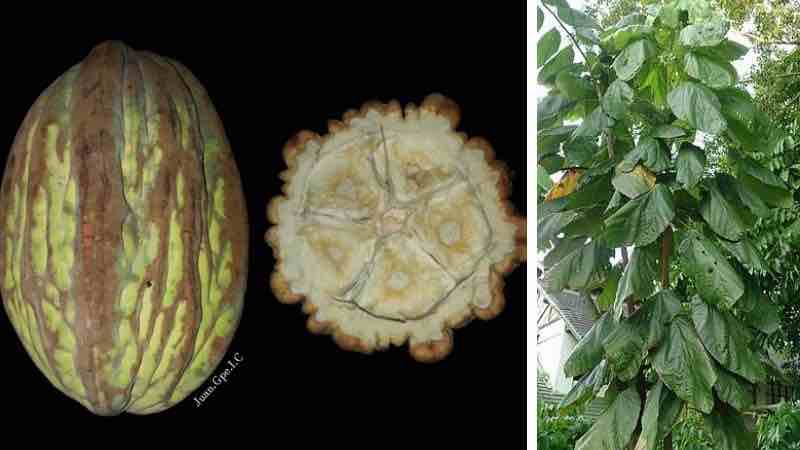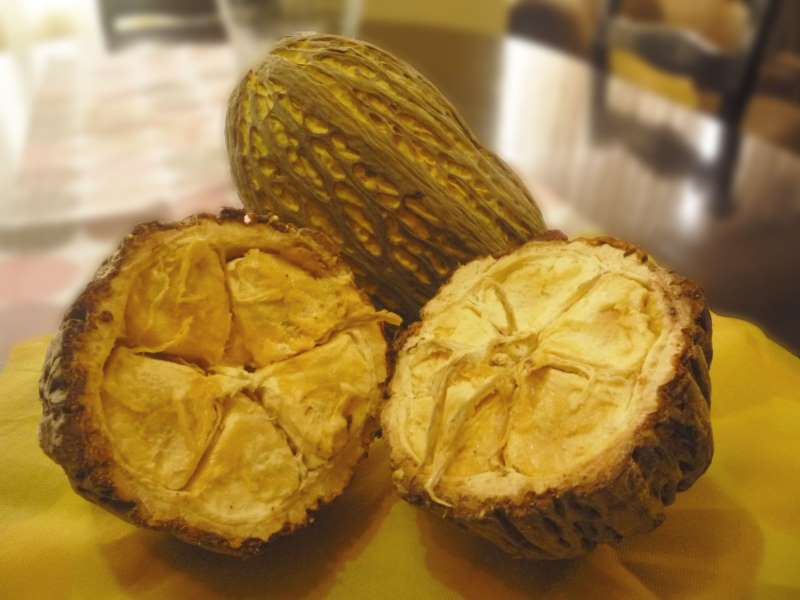
Mocambo Theobroma Bicolor is also commonly known as macambo, pataxte, pataxte cacao, pataste, patashe, cacao cimarrón, and even cacao blanco, inducing confusion with copuazú Theobroma grandiflorum.
In the Peruvian Amazon it is called macao, majambo, wakampe. There the pulp of the fruit is consumed as fresh fruit, its thick, large and hard peel is used as a container.
Its name comes from the fact that it has two colors, which is why it is called jaguar tree.
The mocambo tree characteristics
Trees from 7 to 12 m high. Its trunk is gray, the leaves are alternate, oblong or oval in shape. The fruit is woody, oblong or subglobose-ellipsoidal in shape.

Mokkie / CC BY-SA
The pericarp is hard, with prominent ribs and reticulated intercostal spaces. Its color is greenish brown when unripe, turning yellow or reddish yellow when ripe.
The pulp covering the seeds is cream or pale yellow in color. This species is probably native to Central America and is widespread from Mexico to northeastern Brazil, Colombia, Venezuela, Ecuador and Peru.
The mocambo fruit characteristics
The fruit of Theobroma bicolor is a berry, the largest of the Theobroma genus. It reaches 25 to 35 cm in length and 12 to 15 cm in width.

Its weight varies from 0.5 Kg to 3 Kg. The tree produces between 15 to 40 fruits per harvest. Each fruit contains, on average, about 40 seeds, 16 to 30 mm long and 14 to 25 mm wide, covered by a fibrous, succulent aril.
The fruit is composed, on average, of 27% pulp, 59% peel and 14% seeds. This means that there is a lot of waste if the peel is not used productively.
Uses of mocambo
Macambo has been used in food since pre-Columbian times by the Mayan people. Its use was so relevant that it is mentioned in the Popol Vuh, when a drink called pataxte was elaborated.
It is currently used in Mexico to make candies, such as marzipan and nougat, and even chocolate, mixing its beans with those of Theobroma cacao.

Juan Gpe Ignacio / CC BY-SA
It also prepares “aguas frescas”, popular drinks in Mexico. In the Oaxaca region, a traditional drink known as popo or capuchino oaxaqueño is made.
Nutritional value of mocambo
Experimental research has shown that the seeds of the T. bicolor contain about 51% fat, 17% protein and 13% fiber, which gives it a high nutritional potential and the possibility of becoming a promising ingredient for a functional food and to be a raw material of interest for the chocolate industry.
In this sense, chocolate coating has been made from seeds of T. bicolor and T. grandiflorum.

Dr. Rafael Cartay is a Venezuelan economist, historian, and writer best known for his extensive work in gastronomy, and has received the National Nutrition Award, Gourmand World Cookbook Award, Best Kitchen Dictionary, and The Great Gold Fork. He began his research on the Amazon in 2014 and lived in Iquitos during 2015, where he wrote The Peruvian Amazon Table (2016), the Dictionary of Food and Cuisine of the Amazon Basin (2020), and the online portal delAmazonas.com, of which he is co-founder and main writer. Books by Rafael Cartay can be found on Amazon.com
Resources
Torres, D. E. G., Assunção, D., Mancini, P., Torres, R. P., & Mancini‐Filho, J. (2002). Antioxidant activity of macambo (Theobroma bicolor L.) extracts. European Journal of Lipid Science and Technology, 104(5), 278-281. Fuente
Lim, T. K., & Lim, T. K. (2012). Theobroma bicolor. Edible Medicinal And Non Medicinal Plants: Volume 3, Fruits, 204-207 FUENTE
González, A. A., Moncada, J., Idarraga, A., Rosenberg, M., & Cardona, C. A. (2016). Potential of the amazonian exotic fruit for biorefineries: The Theobroma bicolor (Makambo) case. Industrial Crops and Products, 86, 58-67. Fuente
Jee, M. H. (1984). Composition of the fat extracted from the seeds of Theobroma bicolor. Journal of the American Oil Chemists’ Society, 61(4), 751-753. Fuente
Quijano, C. E., & Pino, J. A. (2009). Analysis of volatile compounds of cacao maraco (Theobroma bicolor Humb. et Bonpl.) fruit. Journal of Essential Oil Research, 21(3), 211-215. PDF
This post is also available in:
![]() Español (Spanish)
Español (Spanish)
